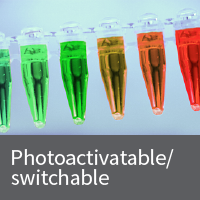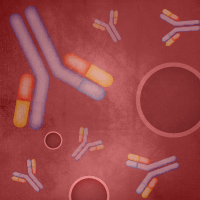Photoactivatable mCherry fluorescent protein

Living Colors PAmCherry is a photoactivatable fluorescent protein (PAFP) derived from the red fluorescent protein mCherry. PAmCherry is non-fluorescent until it is exposed to 350- to 400-nm light. By selecting which cells or cellular regions to activate, you can track cells, organelles, or proteins of interest against a dark background using this photoactivatable fluorescent protein.
Living Colors PAmCherry is a photoactivatable fluorescent protein (PAFP) derived from the red fluorescent protein mCherry. PAmCherry is non-fluorescent until it is exposed to 350- to 400-nm light. By selecting which cells or cellular regions to activate, you can track cells, organelles, or proteins of interest against a dark background using this photoactivatable fluorescent protein. The activated PAmCherry excitation maximum is 564 nm, and the emission maximum is 595 nm, which allows you to visualize and monitor photoactivated PAmCherry with the same filter sets used for other red fluorescent proteins, such as DsRed variants and mCherry.
Photoactivatable fluorescent proteins such as PAmCherry are particularly useful for determining protein half-life and protein transport pathways because molecules synthesized after activation are not able to fluoresce. Therefore, what you observe is a snapshot of the protein molecules that were present at the time of activation.
PAmCherry subcellular localization vectors are available that target PAmCherry to the cell membrane, mitochondria, actin, or tubulin, respectively. Plasmid and lentiviral N- and C-terminal vectors are also available to create your own PAmCherry-tagged protein of interest.
PAmCherry sequence files can be found in the Documents tab by expanding Details within the Product Table below.
Overview
- Switch on the red fluorescent protein mCherry in a subset of cells, proteins, or organelles, in order to track their movement.
- Non-fluorescent until activated by a short exposure to 350- to 400-nm light
(This is the optimal range of wavelengths) - Excitation maximum: 564 nm
Emission maximum: 595 nm - Image PAmCherry with the same filter sets used to detect red fluorescent proteins such as DsRed and mCherry
- Detect PAmCherry with the mCherry monoclonal antibody
More Information
Applications
- Tracking subpopulations of organelles or protein molecules
- Visualizing real-time protein dynamics (movement, degradation, etc.)
- Determining protein half-life and protein transport pathways
- Observing cell division, migration, and morphology
Additional product information
Please see the product's Certificate of Analysis for information about storage conditions, product components, and technical specifications. Please see the Kit Components List to determine kit components. Certificates of Analysis and Kit Components Lists are located under the Documents tab.
Related products
Takara Bio USA, Inc.
United States/Canada: +1.800.662.2566 • Asia Pacific: +1.650.919.7300 • Europe: +33.(0)1.3904.6880 • Japan: +81.(0)77.565.6999
FOR RESEARCH USE ONLY. NOT FOR USE IN DIAGNOSTIC PROCEDURES. © 2025 Takara Bio Inc. All Rights Reserved. All trademarks are the property of Takara Bio Inc. or its affiliate(s) in the U.S. and/or other countries or their respective owners. Certain trademarks may not be registered in all jurisdictions. Additional product, intellectual property, and restricted use information is available at takarabio.com.




